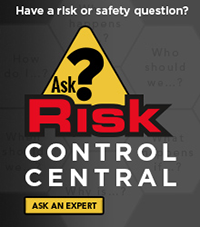Risk Reporter for Educational Facilities
Spring 2016 Vol. 4, Issue 1
In this issue
Security threats to your school system cannot be ignored
Protection (public spaces)
Outdoor Security 101: 5 upgrades every school should consider
Protection (security teams)
Ramp up protection with security teams
Protection (security management)
School security management systems are evolving
Protection (buildings and grounds)
An ounce of prevention keeps buildings, grounds safe
Protection (checklist)
Perimeter Security Protection Checklist
In this issue
Security threats to your school system cannot be ignored
Unfortunately, school buildings and grounds are no longer the safe haven they once were. Criminal acts, vandalism and violence have become increasingly prevalent and no one expects that to change. It is instrumental that carefully thought out security systems and safety plans are in place to keep your administration, staff members and students safe.
Academic administrations are now taking a more involved and active role in establishing and developing safety plans and installing more thorough security upgrades.
This Risk Reporter will show you ways you can increase security at your school. Use the tips to protect your students, your property and yourself from becoming a victim of vandalism or random violence.
Did You Know?
PROPERTY PROTECTION TIP
For assistance with outdoor security planning, call our Risk Control Consulting and Research Center at (800) 554-2642, ext. 5213, or email riskconsulting@churchmutual.com.
Protection (public spaces)
Outdoor Security 101: 5 upgrades every school should consider
Make sure the areas and buildings surrounding your school are just as safe as your learning center.
Here are five simple but important upgrades you can make to help ensure the safety of your students, teachers and employees.
- Consider your foliage. Keep all bushes around your buildings trimmed so people cannot hide behind them.
- Lock your doors. An open-door policy at your school is a nice thought, but the fact is, you need to restrict access. Unlock the front door to your school only during the beginning of the school day when students are arriving, during which time doors should be monitored by security staff, teachers or administrators. Otherwise, install a front door buzzer system along with video monitors at the main entrance. Require all visitors to show a photo ID before letting them into the building.
- Keep track of your keys. Limit key distribution to teachers, administrators and maintenance staff members and keep a record of everyone who has a key. Rekey your locks if a key is lost or not returned.
- Lighting. Outdoor lighting is essential. Ample lighting in the right places makes intruders less likely to target your school. The parking lot and the street entrances also should be well lit.
- Invite the community to get involved. If possible, invite neighborhood volunteers or local parent groups to start a watch program for your school. Neighborhood volunteers have a vested interest in their community and the safety of your school. Ask your local police or sheriff’s department about how to get started.
Did You Know?
PROPERTY PROTECTION TIP
Criminally oriented people will pick an easy opportunity, so don’t let your school be an easy target. Be sure to keep entryways, sidewalks and parking areas well lit. Also, after school hours, keep doors and windows closed and locked. The idea is to make your buildings difficult and high-risk targets for potential vandals.
“Our nation’s schools should be safe havens for teaching and learning, free of crime and violence. Any instance of crime or violence at school not only affects the individuals involved, but also may disrupt the educational process and affect bystanders, the school itself, and the surrounding community.”
— Indicators of School Crime and Safety: 2014
U.S. Department Of Education
U.S. Department Of Justice Office Of Justice Programs
Protection (security teams)
Ramp up protection with security teams
It’s hard to miss reports of crime in the news these days. No one is immune to violence, schools included.
Creating a security team at your school, however, can go a long way toward ensuring the safety of your teachers, students and employees.
Here are tips for creating your security team, putting a plan of action in place and setting standards for its operations.
- A professional security team is highly recommended for schools.
- Identify potential crisis events.
- Establish a written security and violence response plan for your school.
- Train and use your teachers and administrators as a first line of defense to detect potential threats involving suspicious people, packages and vehicles.
- Establish procedures for patrolling exterior and interior areas before, during and after school hours, as well as over the weekend.
- Conduct a security sweep of the entire school building before locking all doors and windows for the day.
- Ask local community groups or Neighborhood Watch programs to keep an eye on the property and report unusual activities to law enforcement.
- Conduct periodic safety surveys of all school buildings and grounds and keep written records of conditions and corrective actions.
- Call police if a suspicious person is on school property and let the police investigate the situation.
- Establish a position on onsite armed protection.
“‘It can’t happen here’ is the biggest and most dangerous myth, as it lulls people into a false sense of security. Disaster takes unexpected forms and strikes when it wants to, not when we are ready for it. That’s why preparedness is so important. Don’t think for a minute it can’t happen to your school.”
— Kevin Jennings
Assistant Deputy Secretary of Education,
Office of Safe and Drug Free Schools
Protection (security management)
School security management systems are evolving
The best way to protect your school from crime is to put a security management system in place.
Many schools have the typical combination of alarms, locks, gates and monitoring equipment, but those aren’t always enough. Today you need to add proven security practices and procedures to complement your security strategy.
You should conduct a thorough security assessment of your buildings and grounds, for example.
Today, it’s fairly common for schools to ask their local police departments to perform a security vulnerability assessment of the school buildings and grounds.
Emergency personnel can show you where your school is most vulnerable. It’s a good idea to take some photos of those areas, too, so you can address the issues later.
Church Mutual recommends hiring a professional security team that specializes in schools. Students, teachers and administrators will immediately feel safer knowing there’s a guard on duty. An in-house security team composed of teachers or staff members also can help identify potential risks as they occur.
Another security trend at schools today is the addition of 24/7 digital surveillance cameras. Having strategically placed cameras both indoors and out can be a powerful deterrent to vandals.
Did You Know?
PROPERTY PROTECTION TIP
Many police officers work security during their off hours. Ask your local law enforcement department if you can hire off-duty officers to provide security during special school events. Plan ahead to ensure police have a better chance of accommodating your school’s schedule.
Protection (buildings and grounds)
An ounce of prevention keeps buildings, grounds safe
They say an ounce of prevention is worth a pound of cure. That’s especially true when it comes to security and protecting school property. Not being prepared now could spell trouble later. To help avoid a potentially dangerous and costly situation, make sure you’re following these practices to harden your school’s perimeter:
- Upgrade your outdoor lighting
Using the right size lamps and fixtures helps create a feeling of safety for teachers, students and administrators. A great reference to check out before installing your outdoor lighting system is the U.S. Department of Energy’s Exterior Lighting for Energy Savings, Security, and Safety. You can view and download the free publication at http://tinyurl.com/zsrhwns.
Also consider replacing any incandescent lights with LED bulbs. LEDs are a little more expensive, but they last longer and are typically brighter and more energy efficient.
- Install security cameras
Today’s digital cameras can connect wirelessly to a recording system in your main office or directly to your security provider. Install them near doorways and other high-traffic areas. Make sure your cameras are near a light source so the images on your video are clear.
- Consider audible alarms
Many times, audible alarm systems are overlooked in favor of silent alarms. The sound of an alarm, however, is exactly what you need to signal an emergency. The sound also can alert neighbors and the surrounding community to the potential danger.
Many alarm systems now come with a pulsating strobe light that is visible for miles. This helps you or authorities pinpoint the exact location that needs attention.
- Install deadbolts
Deadbolts provide the best possible security for interior doors. Consider them for faculty offices, storage rooms and the like. You can get models that use letter combinations, passcodes or even your fingerprint to open doors.
- Consider an electronic keycard system
Many schools today are replacing traditional key systems with keyless, electronic cards. With a keyless system, you can:
- Manage a person’s access via computer
- Identify who used specific doors (and when)
- Deactivate a keycard when a staff member leaves your school
- Add safety curbs and barriers
If you think of your grounds as concentric circles, you want to be sure you have the right safety equipment in each area. In the outer circle, safety typically means controlling foot and automobile traffic.
Terraces, raised plant beds, trees, planters, fencing, gatehouses and bollards also are good protective tools. Many schools are using these types of alternatives to divert traffic, provide added security and beautify their grounds.
Consider temporary barriers for special events or graduation ceremonies, too.
Protection (checklist)
Perimeter Security Protection Checklist
PERIMETER SECURITY PROTECTION CHECKLIST
Name of facility:
Person conducting assessment:
Date:
Establish a neighborhood watch program.
( ) Satisfactory ( ) Needs Attention ( ) Not Applicable
Conduct periodic surveys to ensure exterior security lights are working and placed to illuminate building entrances, sidewalks, steps, loading docks and parking lots.
( ) Satisfactory ( ) Needs Attention ( ) Not Applicable
Trim overgrown trees and shrubs next to buildings to help eliminate hiding places.
( ) Satisfactory ( ) Needs Attention ( ) Not Applicable
Secure local law enforcement for daily/nightly patrols of parking lots and buildings.
( ) Satisfactory ( ) Needs Attention ( ) Not Applicable
Ask local law enforcement to conduct a free security vulnerability assessment of buildings and grounds to determine strengths and weaknesses of current security practices.
( ) Satisfactory ( ) Needs Attention ( ) Not Applicable
Put an access procedure in place for buildings that require people to enter and leave through a main, monitored entrance door.
( ) Satisfactory ( ) Needs Attention ( ) Not Applicable
Reprogram or rekey door locks after a key has been misplaced or not returned.
( ) Satisfactory ( ) Needs Attention ( ) Not Applicable
Conduct security sweeps before, during and after school events by trained staff.
( ) Satisfactory ( ) Needs Attention ( ) Not Applicable
Regularly inspect efficacy of security alarms and/or video surveillance devices.
( ) Satisfactory ( ) Needs Attention ( ) Not Applicable
Conduct security team practice drills on potential crisis situations.
( ) Satisfactory ( ) Needs Attention ( ) Not Applicable
Did You Know?
PROPERTY PROTECTION SOLUTIONS
To ensure you are doing all you can to protect your buildings and grounds, visit Church Mutual’s safety resources library at www.churchmutual.com/98/Safety-Resources. You’ll find checklists, videos, brochures and more.







